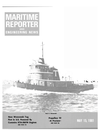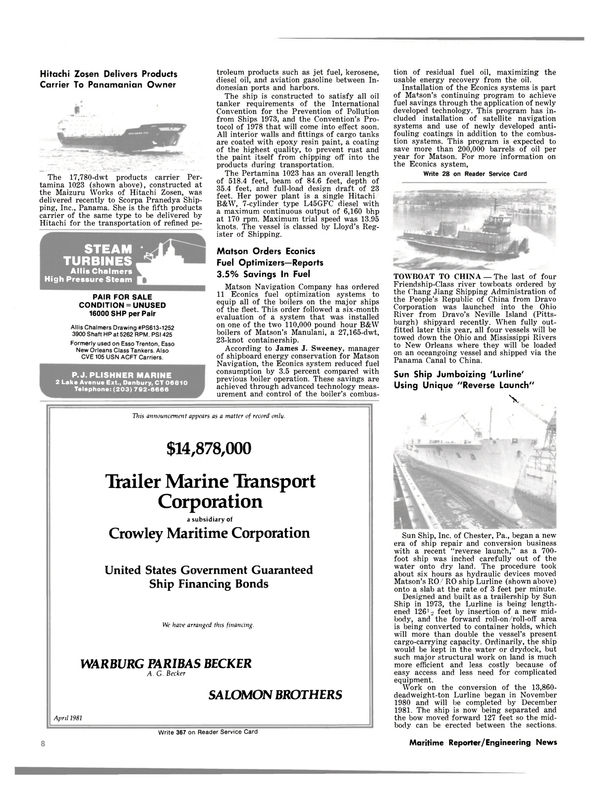
MarAd Study Predicts Big Fuel Savings For Sail Assisted Ships
Small- to medium-sized merchant ships fitted with sails to augment their propulsion plants can achieve substantial fuel savings, and attain a competitive advantage on certain trade routes.
This was a key finding of a 12- month study released recently by the Maritime Administration.
The study, "Wind Propulsion for Ships of the American Merchant Marine," was prepared by Wind Ship Development Corporation of Norwell, Mass., under a MarAd contract. It was prompted by the escalation of ships' fuel prices, which have multiplied by 15-fold during the past decade and are now the largest component of a ship's operating costs.
Sail-assisted vessels in small to medium-size ranges—of 2,000 to 40,000-dwt cargo capacity— could achieve fuel savings of 15 to 25 percent compared with conventionally powered ships, according to the study. The type of sail found to have the greatest economic potential is the wing sail rig or rigid airfoil. Resembling rectangular aircraft wings placed in upright position on a ship's deck, the wing sails can be rotated 360 degrees to obtain the best wind angle, These airfoil sails would be made of metal rather than cloth, and their operation could be automated and remotely controlled.
Copies of the 278-page study are available through the National T e c h n i c a l I n f o r m a t i on Service, 5285 Port Roval Road, Springfield, Va. 22161. The order number is PB-81-162455 and the price is $21.50.
Read MarAd Study Predicts Big Fuel Savings For Sail Assisted Ships in Pdf, Flash or Html5 edition of May 15, 1981 Maritime Reporter
Other stories from May 15, 1981 issue
Content
- Megasystems To Supply Monitoring Equipment For 8 Oceangoing Tugs page: 6
- MarAd Study Predicts Big Fuel Savings For Sail Assisted Ships page: 6
- Dr. P.W. Murrill Elected To Tidewater Board page: 7
- Hitachi Zosen Delivers Products Carrier To Panamanian Owner page: 8
- Matson Orders Econics Fuel Optimizers—Reports 3.5% Savings In Fuel page: 8
- Sun Ship Jumboizing 'Lurline' Using Unique "Reverse Launch" page: 8
- Wronowski Fleet Adds First Boat With Cummins KTA-3067M Engines page: 10
- Promet Launches Offshore Supply Vessel For Jackson Marine page: 10
- Big IOT Petroleum Barge Launched At Galveston Shipbuilding page: 12
- SNAME Northern California Section Hears Paper On "Dejumboizing page: 12
- Mobil Orders Sperry Advanced Navigation System For The 'Mobile Search' page: 13
- B&W Delivers Second Panamax Bulker-14 More On Order page: 14
- Promet W i l l Build The First Of Its Kind Of Rig For Elf page: 16
- G l o b a l M a r i n e Oil A n d Gas Unit Names Hatcher President page: 16
- First Saudi-Owned Shipping Company Gets First Vessel page: 18
- Anastasio Elected President Of Marine Concrete Structures page: 18
- C.T. Palo Appointed Marine Superintendent For McAllister-Philadelphia page: 18
- New Catalog Available From WABCO Describes Marine Control Valves page: 18
- McDermott Unit Renamed —Earles And Foster Appointed Senior VPs page: 19
- Electric Propulsion Systems Discussed At SNAME Chesapeake Section page: 20
- New Lifting Technique Lowers Costs In Construction Of Drilling Rigs page: 20
- Far East-Levingston To Build Drillship For Global Marine page: 21
- PROPELLERS '81 page: 22
- T A N O A w a r d e d $1.9-Million Contract By B I W Yard For A u t o m a t i o n Systems page: 24
- Texaco Names Dubuisson To N e w Offshore Post page: 24
- NICOR Expands Offshore Fleet With Acquisition Of Two Additional Companies page: 26
- Grant Hagen Joins Designers & Planners page: 26
- ASNE Delaware Valley Chapter Holds Meeting At Philadelphia Naval Base page: 28
- Admiral D.G. Iselin Joins Raymond Unit page: 28
- Hitachi Completes Combination Cargo Carrier For Galleon Shipping page: 30
- Penco To Market Showa's Fuel Mixing System page: 31
- Global And Japanese Firm Jointly Offer Offshore Production Systems page: 31
- IHI Delivers Japan's Biggest Helicopter Destroyer page: 33
- Sail Systems For Commercial Ships Could Cut Fuel Costs 30% —Literature Available page: 33
- New Brochure On Hoists, Winches And Mooring Systems Offered By Skagit page: 38
- Nuclear-Powered Sub 'Houston' Launched At Newport News Yard page: 39
- Main Iron Works Delivers Alco-Powered 'Karen Ann' To Corpus Christi Marine Services page: 39
- Designers & Planners Completes Replacement Study On Alaska Ferry page: 40
- Fireboat Design Contract To Nickum & Spaulding page: 42
- GM-Powered Towboat 'Jeanie-K' Delivered By Riverway Shipyard page: 42
- Penco Appointed U.S. Agent For Bremer Vulcan page: 42
- DeJong & Associates To Design New Tug Series For Corps Of Engineers page: 44
- Bailey Reorganizes Miami Operations—Paul Gausted Appointed Vice President page: 44
- New Worldwide Service Company Formed By Racal-Decca Group page: 45
- Van Dawark Appointed President Of Dillingham Maritime Division page: 45
- Avondale Gets $300-Million Contract From Exxon For Three Products Carriers page: 46
- Brochure And Technical Data Sheets Describe ZF Marine Gears page: 46
- Admiral Fugaro Named Senior Vice President Of Great Lakes Towing page: 46
- Two Power Plant Barges For The Philippines Completed By Hitachi page: 47
- Acadiana Shipbuilding Completes Yard Expansion page: 48
- MarAd Approves Title XI On Five Beker Vessels page: 48
- Racker And Vincent Named Assistant Vice Presidents At Lykes Bros. Steamship page: 48
- Levingston Lays Keel For First Jackup Rig For Noble Drilling page: 49
- W.R. Laws Elected To Executive VP At Geosource page: 49
- Sause Bros. Barge-Building Facility In Coos Bay Nearing Completion page: 50
- Biggest Stuelckenmast Floating Crane Delivered By Blohm + Voss page: 51
- Sixth Supply Boat Delivered To Marsea Marine By Halter page: 51
- Navy Awards Tracor $7.6-Million Contract page: 52
- N&SA Names Stumbo And Hagemann Vice Presidents page: 53
- Braden Offers New Series Of Improved Winches- Literature Available page: 53
- Two Double-Hull Bunkering Barges Delivered By Nashville Bridge page: 66
- Cummins-Powered 110-Foot 'Comet7 Delivered To Shippen Marine page: 66


